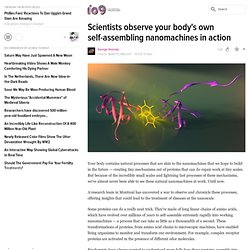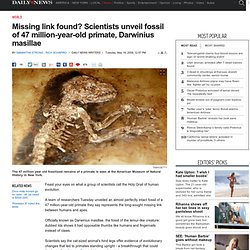

Scientists observe your body's own self-assembling nanomachines in action. Thanks for linking that, utterly amazing.

Isn't it though? What I think is amazing about that simulation is that the machine the transcribes a gene to a length of RNA is able to only accept the molecules that make RNA and it filters and discards all the extraneous molecules in the broth it's traveling through. Very, very quickly. That's a very effective part sorting mechanism flying though the chemical equivalent of cloudy, turbid storm of hurtling molecules of all kinds.
It's the inevitability of it all that really blows my mind. This is interesting, because we usually think of entropy as the great destroyer, but clearly that is not always the case. "This is interesting, because we usually think of entropy as the great destroyer, but clearly that is not always the case. " In a open system, which the Earth is as long as the Sun shines on it and it's core remains molten and active, entropy doesn't win and lots of interesting things happen. Scientist creates lifelike cells out of metal. Scientists trying to create artificial life generally work under the assumption that life must be carbon-based, but what if a living thing could be made from another element?

One British researcher may have proven that theory, potentially rewriting the book of life. Lee Cronin of the University of Glasgow has created lifelike cells from metal — a feat few believed feasible. The discovery opens the door to the possibility that there may be life forms in the universe not based on carbon, reports New Scientist. Even more remarkable, Cronin has hinted that the metal-based cells may be replicating themselves and evolving. "I am 100 percent positive that we can get evolution to work outside organic biology," he said. The high-functioning "cells" that Cronin has built are constructed from large polyoxometalates derived from a range of metal atoms, like tungsten. The metallic bubbles are certainly cell-like, but are they actually alive? The early results have been encouraging. Aerographite Is the World's Lightest Material, Is a Total Airhead and Kind of Weird.
The last time we looked at ultra-lightweight materials, we were thoroughly impressed by a spongy, metallic micro-lattice that held a density of 0.9 milligrams per cubic centimeter (mg/cc). Now, a team of German scientists from the Technical University of Hamburg and University of Kiel has developed a new carbon-nanotube-based material called Aerographite that’s four times lighter at 0.2mg/cc.
As you might have surmised from Aerographite’s name, it’s a material made of mostly air--99.99 percent, to be exact--along with carbon nanotubes. The scientists created the material by growing an interlinking chain of carbon nanotubes onto a zinc oxide template. Despite Aerographite’s lightweight nature, it’s actually quite tough. The material is robust enough to support 40,000 times its own weight.
Because Aerographite is electrically conductive and chemical-resistant, the scientists believe that the material could be used in ultra-lightweight batteries or supercapacitors. The Last Great Ape. Missing link found? Scientists unveil fossil of 47 million-year-old primate, Darwinius masillae. Tama/Getty The 47 million year old fossilized remains of a primate is seen at the American Museum of Natural History in New York.

Feast your eyes on what a group of scientists call the Holy Grail of human evolution. A team of researchers Tuesday unveiled an almost perfectly intact fossil of a 47 million-year-old primate they say represents the long-sought missing link between humans and apes. Officially known as Darwinius masillae, the fossil of the lemur-like creature dubbed Ida shows it had opposable thumbs like humans and fingernails instead of claws. Scientists say the cat-sized animal's hind legs offer evidence of evolutionary changes that led to primates standing upright - a breakthrough that could finally confirm Charles Darwin's theory of evolution.
"This specimen is like finding the Lost Ark for archeologists," lead scientist Jorn Hurum said at a ceremony at the American Museum of Natural History. "It is the scientific equivalent of the Holy Grail. Rschapiro@nydailynews.com.
Pearltrees tips.